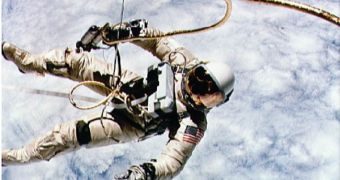Since the beginning of the space age, people who went out there always carried something with them, either to give it value, or to make them feel closer to home. Some were an homage to people who achieved a great deal in the field of astronomy, and here is a list of a few of those objects, compiled by New Scientist.
The Voyager 1 and 2 spacecrafts, currently some 16 billion kilometers away from Earth, carry with them gold record disks, on which conversations in many languages, as well as a map on how to get to our planet, in relation to 14 pulsars are inscribed. The recordings also carry a 1977 message from President Jimmy Carter.
New Horizons, the space probe NASA sent to Pluto, carries, among other precious artifacts, some of the ashes of Clyde Tombaugh, the man who discovered the most remote planet of our solar system. Currently some 1.8 billion kilometers away, NH will reach Pluto in 2015.
During each of their space missions, Russian astronauts hang a “Boris” on the camera, to let the control tower know they are living in weightlessness. A Boris is usually a toy, which dangles in front of the camera, between the objective and the crew. The use of Boris is tightly connected to Russian superstition, and has very little to do with the flight itself.
A small communion chalice was taken to the Moon by Edwin “Buzz” Aldrin, during the Apollo 11 mission. The astronaut took the Holy Communion there, and returned the small item to the Webster Presbyterian Church in Texas, where it's still used to this day, in a yearly ceremony.
A little piece of wood and some fabric from the Wright brothers' first airplane were also taken to the Moon by the Apollo 11 crew, as homage to the men who pioneered the aviation industry, and without which space flight would have been impossible.
In the aftermath of the 9/11 tragedy, Honeybee Robotics, one of the companies in charge of building parts for NASA's Mars Rovers, obtained some metal debris from Ground Zero, which they molded into parts for the crafts. The pair, Spirit and Opportunity, are now surveying opposite sides of Mars.
The “lead tag,” Yames Towne, attached to a cargo ship that brought settlers to newly-founded Jamestown in 1611, was flown in a suborbital flight in 2004 by NASA's space shuttle Atlantis. This was a tribute to the early settlers, who faced the ocean's wrath, in a journey that took many months. The flight over it took merely a few minutes.

 14 DAY TRIAL //
14 DAY TRIAL //